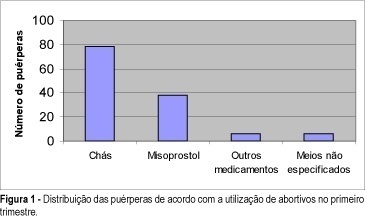Summary
Revista Brasileira de Ginecologia e Obstetrícia. 2001;23(8):529-533
DOI 10.1590/S0100-72032001000800008
Purpose: to evaluate the relationship between bacterial vaginosis (BV) and spontaneous preterm delivery. Method: a total of 611 pregnant women from the general antenatal clinic of the "Clínica Obstétrica do Hospital das Clínicas da Universidade de São Paulo" were enrolled in this study. All pregnancies were dated by an early scan. Iatrogenic preterm deliveries were excluded. The presence of bacterial vaginosis was evaluated between 23 and 24 weeks of pregnancy by a Gram stain of the vaginal smear collected from the posterior vaginal wall using a sterile swab. Vaginal pH was also assessed from the lateral vaginal wall by a Universal 0-14 pH strip produced by Merck. Result: a complete follow-up was obtained in 551 patients and bacterial vaginosis was diagnosed in 103 (19%) cases. Among the patients with BV in the vaginal smear, 9.7% delivered before 37 weeks against only 3.2% in the group with normal vaginal smear (p=0.008). The sensitivity, specificity, accuracy and false-positive rate for preterm delivery in the presence of bacterial vaginosis on Gram stain of the vaginal smear were 41.7, 82, 80.2 and 18%, respectively, with a relative risk of 1.8 for preterm delivery. The mean vaginal pH in the group of positive BV was 4.9 and in the group with normal smear it was 4.3 (p=0.0001). Conclusion: bacterial vaginosis during pregnancy increases the risk for spontaneous preterm delivery, with a relative risk of 1.8.
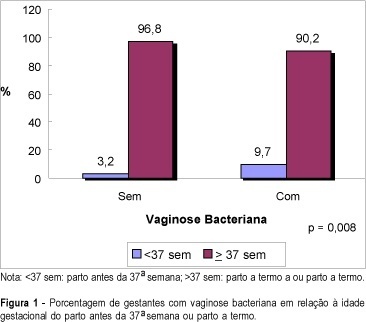
Summary
Revista Brasileira de Ginecologia e Obstetrícia. 2001;23(7):451-455
DOI 10.1590/S0100-72032001000700007
Purpose: to evaluate clinical findings, diagnosis and prognosis of three recent hypercalcemic small cell ovarian carcinoma (HSCC) cases treated in our institution. Methods: information concerning epidemiological data and clinical evolution was obtained from the medical record review. Diagnosis was confirmed through histologic evaluation by our Pathology Department. Results: patients were, at diagnosis, 26, 36 and 38 years old. Tumor diameter ranged from 8.8 cm to 23 cm (mean = 14 cm). All patients presented hypercalcemia with total calcium serum levels of 8.9, 10.8 and 16.7 mEq/dL (NV = 8.8 to 10.2) and ionic calcium levels of 1.26, 1.27 and 1.21 mEq/dL respectively (NV = 1.12 to 1.23). All three patients were submitted to surgical treatment and chemotherapy with platinum-based regimens. In two patients the chemotherapy was adjuvant to the primary surgical treatment. Both are alive and disease-free after 2 and 18 months of follow-up. The other patient had initially the diagnosis of granulosa cell tumor, receiving chemotherapy only after tumor recurrence. Now she is alive with tumor 32 months after diagnosis. Conclusion: the main prognostic factors, in the literature and our experience, are the tumor stage at diagnosis, patient's age, presence of hypercalcemia, large cells, tumor diameter, type of surgical treatment and delay of definitive therapy. The ideal treatment of the hypercalcemic small cell ovarian carcinoma remains unknown. Difficulties in determining a standard therapeutic strategy include rarity of the neoplasm, frequently inadequate initial staging, difficulties in histologic diagnosis and multiple therapeutic approaches.
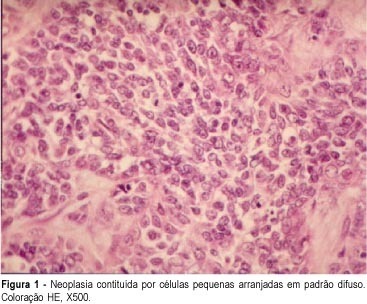
Summary
Revista Brasileira de Ginecologia e Obstetrícia. 2001;23(8):523-527
DOI 10.1590/S0100-72032001000800007
Purpose: to study perinatal outcome in asthmatic pregnant patients who required hospital admission to control acute exacerbations. Patients and Method: retrospective study of 12 pregnant asthmatic patients admitted at the Hospital das Clínicas, Department of Obstetrics and Gynecology, FMRP-USP, during the period between 1992 and 1996. The analyzed data included: maternal age, prenatal care, length of hospitalization, gestational age at delivery, type of delivery, neonatal weight and Apgar score. Results: among the 12 asthmatic pregnant patients 7 did not have prenatal care for acute exacerbation treatment before hospitalization. Three of 12 developed preeclampsia (one with premature rupture of membranes and infection of the amniotic cavity and one with premature separation of the placenta); 2 of 12 were diagnosed with premature placental aging (one with premature labor and twin-to-twin transfusion syndrome and one with oligohydramnios); 1 of 12 was diagnosed with oligohydramnios and fetal death and had pneumonia, and 1 of 12 was diagnosed with polyhydramnios. Among the infants, 3 were small for gestational age. Conclusions: perinatal complications were more frequent in asthmatic pregnant patients who required hospital care for the acute exacerbations. Chronic asthmatic patients in reproductive age should be advised before pregnancy about the prophylactic measures to reduce the incidence of acute crises and exacerbations during pregnancy should be treated promptly.
Summary
Revista Brasileira de Ginecologia e Obstetrícia. 2001;23(7):445-448
DOI 10.1590/S0100-72032001000700006
Purpose: to evaluate the results of 64 hysteroscopic endometrial ablations using a resectoscope in women with abnormal uterine bleeding of benign etiology and nonresponsive to clinical measures and to describe the failures and their associated conditions. Methods: sixty-four patients with abnormal uterine bleeding were submitted to the intervention between April 1994 and February 2000. The mean age was 42.9 years and the mean parity, 2.6 deliveries. Diagnostic hysteroscopy and endometrial biopsy were performed preoperatively. Before surgery, two women received gestrinone, six danazol and 44 GnRH analogue. During the surgery electric cauterization of the fundus uteri and cornual regions was made. Afterwards, with a resectoscope, the endometrium was removed as far as 1 cm above the internal ostium, and as deep as 2 to 3 mm into the myometrium. The uterine distension was obtained with 1.5% glycine and since two years ago with 3% manitol. The average follow-up was 11.5 months. After six months of endometrial ablation, the patients with persistence of symptoms were submitted to hysterectomy. Results: amenorrhea occurred in 31.2% of the patients and hypomenorrhea in 45.3%. The abnormal bleeding was maintained in 23.5%. There was one uterine perforation during the dilatation of the cervix. Results were better in the higher age and parity ranges and in the women who received GnRH analogues (p=0.03). Where the method was not successful there was a statistically significant frequency of submucous myoma (p=0.04) and a nonsignificant increase of secretory endometrium (p=0.12). Conclusions: the method is useful for the management of abnormal uterine bleeding of benign etiology. Previous administration of GnRH analogue is recommended. We suggest a special follow-up for the younger, low parous women, and those with submucous myoma, because they are the group with the poorest results.
Summary
Revista Brasileira de Ginecologia e Obstetrícia. 2001;23(7):439-443
DOI 10.1590/S0100-72032001000700005
Purpose: to evaluate the percentage of 45- to 60-year-old women complaining of urinary incontinence, who look for medical treatment, and the factors possibly associated with the decision of visiting the doctor and the reasons for not doing so. Methods: a secondary analysis of a population-based survey on climacterium and menopause in women living in the city of Campinas, São Paulo state, was carried out through a descriptive, exploratory and cross-sectional population study. A total of 456 women between 45 and 60 years of age were selected through a sampling process. The age at menopause and its associated factors were evaluated, as well as the prevalence of climacteric symptoms, the use of medical care, self-perception of the health status, and the sociocultural, sociodemographic and socioeconomic characteristics. Urinary incontinence complaint and the search for medical help due to the presence of symptoms were explored. The data were collected through home interviews, using a structured and pretested questionnaire provided by the International Health Foundation/International Menopause Society and by the North American Menopause Society, and adapted by the authors. The statistical analysis was performed using Fisher's exact test. Results: thirty-five percent of the interviewees reported constant or intermittent stress incontinence, although only 59% of the patients with the complaint sought medical help. Conclusion: the majority of the women presenting urinary incontinence do not complain to the doctor if they are not questioned objectively.
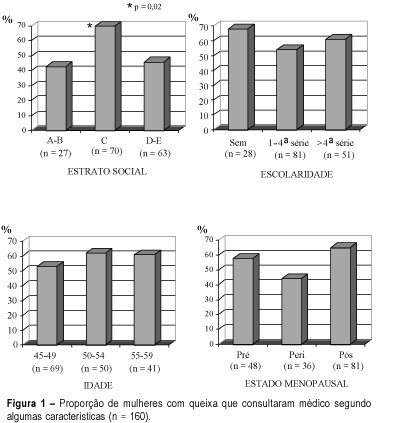
Summary
Revista Brasileira de Ginecologia e Obstetrícia. 2001;23(7):431-438
DOI 10.1590/S0100-72032001000700004
Purpose: to evaluate the association between the presence of diastolic notch in the maternal uterine arteries, and the histopathological changes of the uteroplacental vessels. Methods: transversal study of 144 women with single pregnancy interrupted by cesarean section between 27 and 41 weeks. In this sample, 84 had pregnancies complicated by preeclampsia and the other 60 were normal. In this group, Doppler study of both uterine arteries and placental bed biopsy was performed. Results: of the total of 144 patients, 88 patients (61%) had a biopsy fragment that was considered representative of the placental bed. The diastolic notch was present in 40 patients (70%) of the total of cases with inadequate physiologic alterations and absent in 28 patients (90%) of the total of cases with physiologic alterations (p=0.0000). The Doppler study showed 70% sensitivity, 90% specificity, 44% positive predictive value and 97% negative predictive value. The association between bilateral diastolic notch of uterine arteries and acute atherosis in the placental bed was also significant (24 out of 25 cases -- p=0.000). The Doppler study showed 96% sensitivity, 70% specificity, 26% positive predictive value and 99% negative predictive value, while for arteriolosclerosis its results were 80% sensitivity, 55% specificity, 17% positive predictive value and 96% negative predictive value. Conclusions: the diastolic notch in the maternal uterine is a safe indicator of pathological vessel alteration in the placental bed. The adequate trophoblast migration into the myometrium, revealed by physiologic changes, results in the absence of bilateral diastolic notch of the maternal uterine arteries.
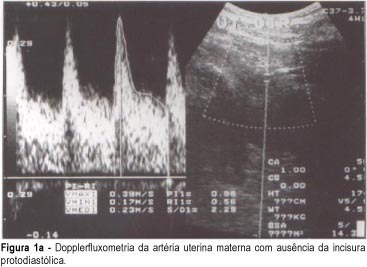
Summary
Revista Brasileira de Ginecologia e Obstetrícia. 2001;23(7):423-427
DOI 10.1590/S0100-72032001000700003
Purpose: to evaluate the impact of birth time interval between twins in relation to the morbidity and mortality of the second newborn twin. Methods: this is a retrospective study of 50 women with twin pregnancy at the `Maternidade Pró-Matre de Vitória' who gave birth to 100 alive newborns through the vaginal canal, weighing each over 500 g and not having any major malformations. The newborns were separated into two groups: G1 (first twin) and G2 (second twin). The following criteria were considered to be indicative of newborn morbidity: asphyxia at birth, characterized by Apgar index lower than 7 in the first minute of life; respiratory distress syndrome detected by clinical and radiological findings, and hospitalization period longer than 4 days. In-hospital mortality was analyzed as well. Cut off was at every 5 minutes, up to 35 minutes, to study the time interval between the twin (deltat) delivery. A time-span (deltat) analysis was also carried out up to 5 minutes: 6-10, 11-15, 16-20, and 21-150 minutes. Results: there were no statistically significant differences between the second twin's morbidity/mortality in relation to the first, considering the aforesaid cutoff and time-span levels. Conclusion: delivery time interval between G1 and G2 did not influence the second twin's morbidity and mortality; however, in the assistance of the second twin's delivery, it is absolutely necessary to individualize the characteristics of each case, not allowing any anxiety to set in through untimely and potentially damaging procedures.
Summary
Revista Brasileira de Ginecologia e Obstetrícia. 2001;23(8):517-521
DOI 10.1590/S0100-72032001000800006
Purpose: to verify the association of the use of abortifacient drugs during the first 3 months of gestation with the occurrence of congenital malformations in live births. Patients and Methods: population-based case-control study through selection of the first six live births on a day, over the period of a year, at a public maternity in Salvador, Bahia, with a total of 800 cases. Studies were performed through investigation of birth records in the search of congenital malformation data, observation of selected malformed newborns, followed by interview with the mothers for collection of anamnesis data, by application of a questionnaire. Later on data were statistically evaluated by Epi-Info 5.0 software. Results: puerperae came from a low socialeconomic class (74.8%), without any or almost any schooling (61.1%). The general percentage of birth defects was estimated at 4.7%. Out of 800 puerperae, 16% reported abortifacient drug intake during the first 3 months of gestation and 10.9% of them had malformed babies. This incidence was 3.6% in children whose mothers denied the intake of any abortifacient drugs. Agents most commonly taken in those unsuccessful abortive attempts were misoprostol (Cytotec) and herbs, specially "alumã" (Vermonia baiensis Tol) and "espinho cheiroso" (Kanthoxilum shifolium Lam), which, according to the literature, do not really have any abortive effect. Conclusion: the study revealed the extension of intentional miscarriage in a low income population and showed that the occurrence of birth defects could be related to gestational exposure to misoprostol and herbal medicine intake.
